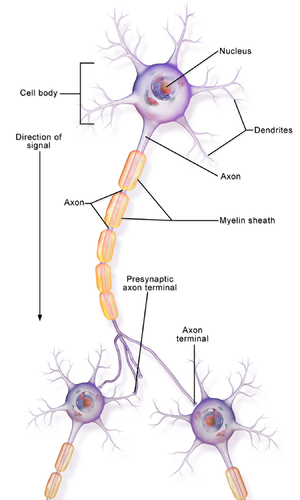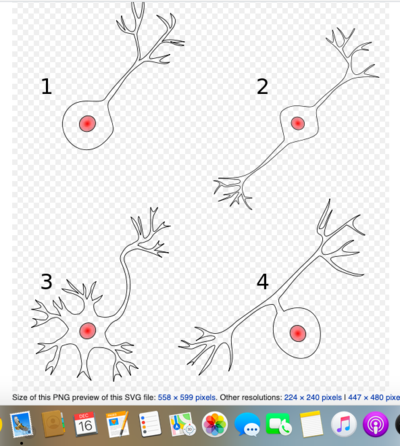Neurone
Original Editor - Lucinda hampton
Top Contributors - Lucinda hampton, Kim Jackson, Rucha Gadgil, Manisha Shrestha and Stacy Schiurring
Introduction[edit | edit source]
Neurones are cells of the central nervous system, located within the grey matter, and responsible for all neurological functions of the brain[1].
Basic Facts:
- Cell body of a neuron contains the nucleus and lysosomes and is the site of synthesis and degradation of virtually all neuronal proteins and membranes.
- Axons are long processes specialized for the conduction of action potentials away from the neuronal cell body.
- Action potentials are sudden membrane depolarizations followed by a rapid repolarization. They originate at the axon hillock and move toward axon terminals, where the electric impulse is transmitted to other cells via an electric or chemical synapse.
- Most neurons have multiple dendrites, which receive chemical signals from the axon termini of other neurons.
- When an action potential reaches a chemical synapse, a neurotransmitter is released into the synaptic cleft. Binding of the neurotransmitter to receptors on the postsynaptic cell changes the ion permeability and thus the electric potential of the postsynaptic plasma membrane.
- Neurons are organized into circuits. In a reflex arc, such as the knee-jerk reflex, interneurons connect multiple sensory and motor neurons, allowing one sensory neuron to affect multiple motor neurons. One muscle can be stimulated to contract while another is inhibited from contracting[2]
Structure[edit | edit source]
Neurones vary in morphology and size substantially, but all share a number of features :
Cell body.
- Contains the nucleus and is the site of synthesis of virtually all neuronal proteins and membranes. Some proteins are synthesized in dendrites, but no proteins are made in axons and axon terminals, which do not contain ribosomes. Proteins and membranes that are required for renewal of the axon and nerve termini are synthesized in the cell body and assembled there into membranous vesicles or multiprotein particles.[2]
- Perikaryon: cytoplasm surrounding the nucleus
Axon
- Generally the 'output' of the neurone
- Specialized for the conduction of a particular type of electric impulse, called an action potential, outward, away from the cell body toward the axon terminus. An action potential is a series of sudden changes in the voltage, or equivalently the electric potential, across the plasma membrane. When a neuron is in the resting (nonstimulated) state, the electric potential across the axonal membrane is approximately −60 mV (the inside negative relative to the outside); the magnitude of this resting potential is similar to that of the membrane potential in most non-neuronal cells. At the peak of an action potential, the membrane potential can be as much as +50 mV (inside positive), a net change of ≈110 mV. This depolarization of the membrane is followed by a rapid repolarization, returning the membrane potential to the resting value. These characteristics distinguish an action potential from other types of changes in electric potential across the plasma membrane and allow an action potential to move along an axon without diminution[2].
- Single process of variable length (even over a metre)
- Axonal transport: carried out by proteins such as kinesin and dynein, and has antegrade and retrograde movement.
- Anterograde transport - materials are transported along microtubules down the length of the axon to the terminals, where they are inserted into the plasma membrane or other organelles.
- Retrograde transport - Axonal microtubules transport damaged membranes and organelles up the axon toward the cell body. Lysosomes, where such material is degraded, are found only in the cell body[2].
- terminates in terminal buttons which release neurotransmitters
- Most of the volume of our brain is occupied by axons, which form a complex network called white matter. Like a maze of airways linking cities around the world, white matter manages communication and co-ordination between the various areas where populations of neurons process information. These areas are located in different parts of the brain, sometimes close to each other, sometimes far away: this is the principle of distributed computing[3].
Dendrites
- Generally the 'input' of the neurone
- Most neurons have multiple dendrites, which extend out-ward from the cell body and are specialized to receive chemical signals from the axon termini of other neurons. Dendrites convert these signals into small electric impulses and transmit them inward, in the direction of the cell body. Neuronal cell bodies can also form synapses and thus receive signals
- Particularly in the central nervous system, neurons have extremely long dendrites with complex branches. This allows them to form synapses with and receive signals from a large number of other neurons, perhaps up to a thousand.
- Electric disturbances generated in the dendrites or cell body spread to the axon hillock. If the electric disturbance there is great enough, an action potential will originate and will be actively conducted down the axon[2].
Types of neurones[edit | edit source]
Three main morphological patterns of neurones are described, depending on the relationship of the cell body to the axon and dendrites.[1] Image R: 1: Unipolar neuron 2: Bipolar neuron 3: Multipolar neuron 4: Pseudounipolar neuron
- Multipolar neurons: most common type of neuron. They are located in the central nervous system (brain and spinal cord) and in autonomic ganglia. Multipolar neurons have more than two processes emanating from the neuron cell body.
- Bipolar: relatively rare. They are sensory neurons found in olfactory epithelium, the retina of the eye, and ganglia of the vestibulocochlear nerve.
- Unipolar/pseudounipolar[1]: sensory neurons with cell bodies located in spinal and cranial nerve ganglia. (Note: unipolar neurons are sometimes called pseudo-unipolar because embryologically they originate as bipolar neurons and subsequently become unipolar.)[4]
Sub Heading 2[edit | edit source]
Healing of Neurones[edit | edit source]
Factors influencing nerve healing potential following repair include:
- Age: the most important factor. Younger patients have more positive outcomes (compared to adults) and the recovery time is quicker. Studies have shown that, even in the pediatric population, patients < 6 years of age recovery more quickly compared to their adolescent counterparts
- Level of injury: distal injuries have a better chance of recovery compared to more proximal injuries
- Injury pattern: sharp lacerations/transections do better than crush injuries
- Delay in repair: chronic injuries do poorly
- The technique of surgical repair is critical: Secondary tissue damage occurs with excessive handling; Nerve endings should be properly aligned (and not under tension) during a direct repair; Excessive suture material used during the repair risks the development of a neuroma at the site of repair[5].
Neurodegenerative Disorders[edit | edit source]
Many conditions can affect neurons and their transmission. Some of these include neurodegenerative diseases eg Motor Neurone Disease (MND), some dementias, Huntington disease, spinal and bulbar muscular atrophies, as well as lesions of the motor neurons.
Adult Neurogenesis[edit | edit source]
- see link
Resources[edit | edit source]
- bulleted list
- x
or
- numbered list
- x
References[edit | edit source]
- ↑ 1.0 1.1 1.2 Radiopedia Neurone Available from;https://radiopaedia.org/articles/neurone (last accessed 16.12.2020)
- ↑ 2.0 2.1 2.2 2.3 2.4 Lodish H, Berk A, Zipursky SL, et al. Molecular Cell Biology. 4th edition. New York: W. H. Freeman; 2000. Section 21.1, Overview of Neuron Structure and Function. Available from: https://www.ncbi.nlm.nih.gov/books/NBK21535/ (accessed 16.12.2020)
- ↑ The Conversation Brains manage neurons like air traffic controllers manage airplane movements Available from;https://theconversation.com/brains-manage-neurons-like-air-traffic-controllers-manage-airplane-movements-141685 (last accessed 16.12.2020)
- ↑ Lab 1: Nervous Tissue Histology Neurons -- Multipolar Neurons Available from:http://vanat.cvm.umn.edu/neurLab1/neuron.html (last accessed 16.12.2020)
- ↑ Ludwig PE, Varacallo M. Neuroanatomy, Neurons. InStatPearls [Internet] 2018 Nov 14. StatPearls Publishing.Available from;https://www.ncbi.nlm.nih.gov/books/NBK441977/ (accessed 16.12.2020)








